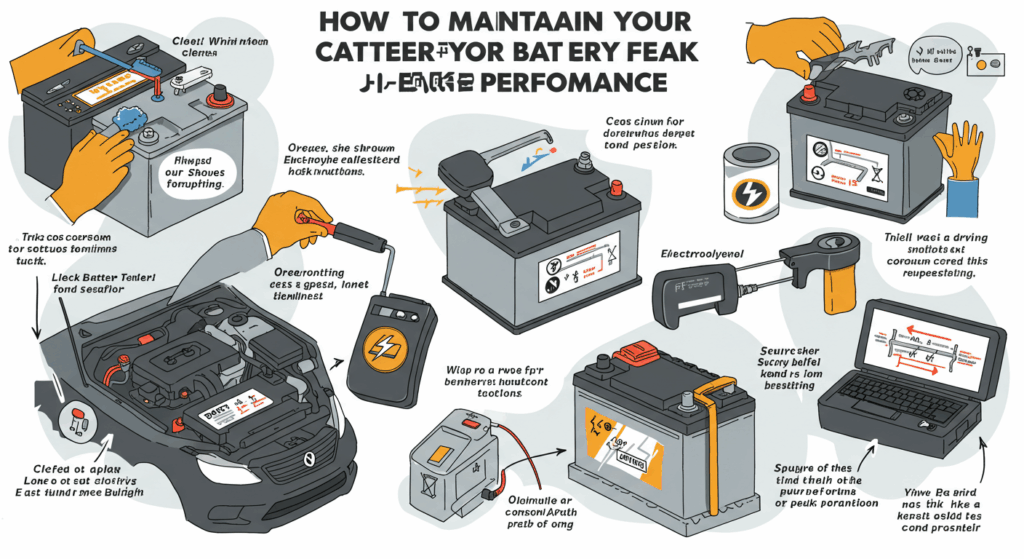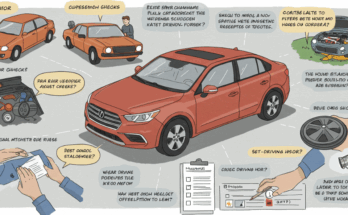Your car battery is the unsung hero of your vehicle, quietly powering everything from the ignition to the lights and electronics. Without a healthy battery, your car won’t start, and you could find yourself stranded at the worst possible moment. Maintaining your car battery for peak performance is not only about extending its lifespan but also ensuring your vehicle runs smoothly and reliably. This comprehensive guide will walk you through the essentials of car battery maintenance, offering practical tips and expert advice to keep your battery in top shape.
Understanding Your Car Battery
Before diving into maintenance tips, it’s important to understand the basics of your car battery. Most vehicles use a lead-acid battery, which generates electrical power through a chemical reaction between lead plates and an electrolyte solution (typically sulfuric acid and water). Modern cars may also use Absorbed Glass Mat (AGM) or lithium-ion batteries, which are more advanced and require slightly different care. Regardless of the type, all batteries have a finite lifespan, typically lasting 3 to 5 years under normal conditions. Proper maintenance can help you maximize this lifespan and avoid unexpected failures.
Why Battery Maintenance Matters
A well-maintained battery ensures your car starts reliably, powers essential systems, and prevents costly repairs or replacements. Neglecting your battery can lead to corrosion, reduced performance, or complete failure, especially in extreme weather conditions. By following a regular maintenance routine, you can save time, money, and frustration while keeping your vehicle in peak condition.
Step-by-Step Guide to Maintaining Your Car Battery
Here’s a detailed breakdown of how to maintain your car battery for optimal performance. These steps are designed for the average car owner and require minimal tools or expertise.
1. Inspect the Battery Regularly
Routine visual inspections are the first step in battery maintenance. Check your battery at least once every three months or before long trips. Here’s what to look for:
- Corrosion on Terminals: Look for white, powdery buildup around the battery terminals. This is usually caused by acid leakage or chemical reactions with moisture. Corrosion can weaken the connection between the battery and the vehicle’s electrical system.
- Cracks or Leaks: Inspect the battery case for cracks, bulges, or signs of leaking electrolyte fluid. If you notice any damage, replace the battery immediately, as leaks can be hazardous.
- Secure Mounting: Ensure the battery is securely fastened in its tray. Vibrations from a loose battery can cause internal damage and shorten its lifespan.
Tip: Wear gloves and safety glasses when inspecting your battery to protect yourself from acid and debris.
2. Clean the Battery Terminals
Corrosion on battery terminals is a common issue that can impede electrical flow. Cleaning the terminals is simple and requires basic tools like a wire brush, baking soda, water, and a cloth.
Steps to Clean Terminals:
- Disconnect the battery cables, starting with the negative (-) terminal, followed by the positive (+) terminal, to avoid short-circuiting.
- Mix a solution of one tablespoon of baking soda with one cup of water.
- Apply the solution to the terminals using a brush or cloth to neutralize and remove corrosion.
- Scrub the terminals with a wire brush to remove stubborn buildup.
- Rinse with clean water and dry thoroughly with a clean cloth.
- Reconnect the cables, starting with the positive (+) terminal, then the negative (-).
Tip: Apply a thin layer of petroleum jelly or dielectric grease to the terminals after cleaning to prevent future corrosion.
3. Check the Battery’s Charge
A battery’s charge level directly affects its performance. Most modern vehicles have a charging system that keeps the battery topped up, but it’s still a good idea to check the charge periodically, especially if your car has been sitting unused for a while.
- Use a Multimeter: A multimeter is an affordable tool that measures the battery’s voltage. A fully charged battery should read around 12.6 volts when the car is off. If the voltage is below 12.4 volts, the battery may need charging.
- Test During Cranking: Start the car and measure the voltage again. A reading between 13.7 and 14.7 volts indicates that the alternator is charging the battery properly.
If the battery is consistently low on charge, it may indicate a problem with the alternator or a parasitic drain (when electronics draw power even when the car is off). Consult a mechanic if you suspect an issue.
4. Keep the Battery Charged
Batteries naturally lose charge over time, especially if the car isn’t driven regularly. This is known as self-discharge and can be accelerated by extreme temperatures or electrical loads.
- Drive Regularly: Driving your car for at least 20-30 minutes weekly helps the alternator recharge the battery. Short trips (under 10 minutes) may not provide enough time for the battery to recharge fully.
- Use a Battery Maintainer: If you don’t drive often, invest in a battery maintainer or trickle charger. These devices keep the battery at an optimal charge level without overcharging. Connect the maintainer when the car will be unused for more than a week.
- Avoid Draining Accessories: Turn off lights, infotainment systems, and other electronics when the engine is off to prevent unnecessary battery drain.
5. Protect Against Extreme Temperatures
Temperature extremes—both hot and cold—can take a toll on your battery’s performance and lifespan.
- Cold Weather: Cold temperatures reduce a battery’s ability to hold a charge. Before winter, test the battery’s charge and ensure it’s fully charged. Consider using an insulated battery blanket in extremely cold climates to maintain optimal operating temperature.
- Hot Weather: Heat accelerates chemical reactions inside the battery, leading to faster degradation. Park in shaded areas or a garage to minimize exposure to high temperatures. Check the electrolyte levels (if accessible) in hot climates, as heat can cause evaporation.
6. Test the Battery Annually
Have your battery professionally tested once a year, especially before extreme weather seasons. Most auto shops offer free or low-cost battery testing using specialized equipment that measures the battery’s cold cranking amps (CCA) and overall health. This test can help you catch potential issues before they lead to failure.
7. Know When to Replace the Battery
Even with excellent maintenance, all batteries eventually wear out. Signs that your battery needs replacement include:
- Slow engine cranking or difficulty starting the car.
- Dim headlights or weak electrical systems.
- A battery age of 3-5 years, depending on usage and climate.
- Frequent need for jump-starts.
When replacing your battery, choose one that meets your vehicle’s specifications (check the owner’s manual for size, CCA rating, and type). Opt for a reputable brand with a good warranty, and ensure proper recycling of the old battery.

Additional Tips for Long-Term Battery Health
- Minimize Electrical Loads: Avoid adding aftermarket accessories like high-powered stereos or additional lighting, as they can strain the battery and alternator.
- Check the Alternator: A faulty alternator can overcharge or undercharge the battery, leading to premature failure. If your battery dies frequently, have the alternator tested.
- Store Properly During Long Periods of Inactivity: If you’re storing your car for an extended period (e.g., during winter), disconnect the negative battery terminal or use a battery maintainer to prevent discharge.
- Follow Manufacturer Guidelines: Some batteries, like AGM or lithium-ion, have specific maintenance requirements. Refer to your vehicle’s manual for guidance.
Common Mistakes to Avoid
- Ignoring Warning Signs: Don’t dismiss slow starts or dim lights as minor issues. These are often early indicators of battery trouble.
- Overcharging: Using a charger with the wrong voltage or leaving it connected too long can damage the battery.
- Improper Handling: Always handle batteries with care, as they contain hazardous materials. Never attempt to open a sealed battery or dispose of it improperly.
The Environmental Impact of Battery Maintenance
Proper battery maintenance isn’t just about performance—it’s also about environmental responsibility. Car batteries contain lead and acid, which can be harmful if not disposed of correctly. Always recycle old batteries at a certified recycling center or auto shop. Many retailers offer recycling services when you purchase a new battery. By maintaining your battery properly, you can extend its life and reduce the frequency of replacements, minimizing your environmental footprint.
Conclusion
Maintaining your car battery for peak performance is a straightforward process that pays off in reliability and cost savings. By regularly inspecting, cleaning, charging, and testing your battery, you can prevent unexpected breakdowns and extend its lifespan. Whether you’re a daily commuter or an occasional driver, these tips will help you keep your car’s battery in top condition, ensuring your vehicle is always ready to hit the road. Take a few minutes every few months to care for your battery—it’s a small investment of time that delivers big rewards.



